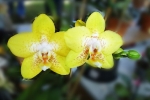Phalaenopsis or the moth orchid is perhaps one of the best orchids grown as houseplants and is one of the favorites of those who have emissions.
Well-developed plants will bloom often as you know, even for several times a year, although their season begins in late winter.
The average temperatures and the conditions under ordinary found in houses seem to be sufficient in general. The flower stems can be forced to bloom again in some hybrids if they cut the top, after being the first flower.

Only healthy plants should be induced to continue flourishing.
Its generic name comes from Greek, where “phalaina” means “moth” and “opsis” means “like” and, of course, describes the species of Phalaenopsis flowers resembling moths in flight. This is why the popular name of the plant is the moth orchid.
The Phalaenopsis are originated from Southeast Asia, the area between the Himalayas to the islands and Palawan in the Philippines Polillo and northern of Australia.
Most of them are epiphytic plants that live in the shade. In natural habitat they are found usually in wet forests, protected from direct sunlight, but also in dry or cold environments. The Phalaenopsis species have adapted to these conditions individually.
Phalaenopsis has no pseudo bulbs. It blooms in their full way for several weeks. If they are kept indoors, the flowers usually last 2-3 months, a period long enough.
The Phalaenopsis orchid species can be divided into two groups:
1. The Phalaenopsis group, where their flowering is large, almost round; the branches are long (up to 1 meter long) having pink and white ties;
2. The second Phalaenopsis group where the waxy flowers and short stems are found.
In the specialized terminology, Phalaenopsis orchid is defined as hemicriptofite or camerofite (the terms are synonymous)
– Hemicriptofite: it is a biennial or perennial plant with herbaceous stems that are destroyed immediately after the growing season, but the shoots remain at ground level.
– Camerofite: they are low plants with herbaceous stems and / or wood that persists for many years.
The Phalaenopsis orchid is not only beautiful. Like many other plants, the flower petals attract pollinating insects; it must realize that and protect the essential organs. After pollination, the petals enter into a process of senescence (wilt / decays) for the plant no longer affords to consume energy to keep it. Many species of Phalaenopsis – an example of this is P. purple – the sepals and the petals meet each other’s role after the pollination is done.
Phalaenopsis Pictures Gallery



